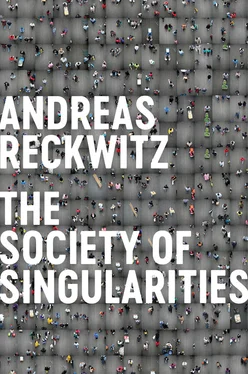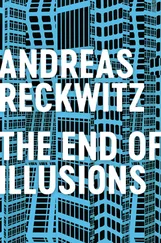1 ...8 9 10 12 13 14 ...30 Within the rationalistic logic of the general, the spatiality of the social involves the replication of identical or similar spaces. 21In this case, space is extensive and serial to the extent that it allows identical structures – series of the same thing – to extend beyond local contexts. What is more, rationalistic spatiality integrates a sort of container model into social reality by clearly assigning particular types of spaces to particular activities. Industrial cities, for instance, are characteristic of seriality and its container-like nature. In the sense of “serial construction,” their components are in part even identical, so that they can literally be exchanged with one another. 22Here, spatiality is functional and oriented toward the directive of technical (and normative) rationality. It accordingly entails a rigid spatial separation of individual activities (work, habitation, leisure, etc.).
The social logic of the general functions in an analogous way on the level of temporality . In classical modernity, time was rationalized, and this involved the standardization of comparable synchronized intervals. 23Here it is characteristic that social praxis comes to be structured according to repetitive acts in time (the paradigmatic example of this is at the workplace) and that spaces of time are filled up in equal ways (thus the working week standardizes working conditions). The mode that shapes time in such a way is thus not the event but rather the routine; it is not a matter of occupying a given moment but rather one of reducing time’s emotional qualities. It should also be noted that this sort of time is future-oriented: the present is only instrumentally interesting as a contribution toward achieving a future goal, whereas the past is closed off and seems obsolete. Time thus becomes the central object of future planning, which is understood in terms of progress, improvement, or growth. On the level of the lives of subjects, this corresponds to the model of linear biography.
What sort of collectives are produced by the rationalistic logic of the general? More revealing, perhaps, is the sort of past collectives that this logic is oriented against: traditional communities based on personal connections. These were replaced by the organization – that is, by an objectifying and impersonal collective formed to achieve a given purpose (the organization is thus an expression of the general principles of formal rationality). 24At their heart, classical organizations are based on clear technical-normative rules and hierarchized responsibilities, on membership and qualifications, and on predictable decision-making. The bureaucratic state is thus just as paradigmatic of modern organization as are capitalist and socialist firms. Within the framework of the social logic of the general, organizations are typically structured in the same way regardless of their respective purposes, and they are thus experienced by subjects as similarly designed entities (as organizations, hospitals are more or less the same as schools, government agencies, corporations, etc.).
Finally, the rationalistic logic of the general and its formal rationality also manifest themselves in the overall form of social praxis in which subjects, objects, spaces, temporalities, and collectives participate. Here there is an overarching mode of praxis . In the latter, all practices tendentially take the form of instrumentally rational or normative-rational activity, so that they are explicitly oriented toward pursuing objectives or following social rules. The instrumentally rational treatment of objects and normatively regulated interactions (between those present or absent) are paradigmatic of this, and the conceptual pair “labor and interaction” can thus be said to designate the rationalistic mode of praxis as a whole. 25The result is that, for the most part, activity here is no longer habitual but is rather routinized; in other words, it is now based on the sedimentation of explicitly and consciously refined, optimized, or perfected rules.
Industrial Modernity as a Prototype
Generally speaking, the history of Western modernity can be divided into three phases: bourgeois modernity, organized modernity, and late modernity. 26Over the course of the eighteenth and nineteenth centuries in Europe and North America, bourgeois modernity gradually ousted the traditional feudal and aristocratic society. During this stage, a social logic of the general came to prominence in various sectors of society on account of early industrialization, the philosophy of the Enlightenment, 27the rise of science, the emergence of transregional commodity markets and capitalist structures of production, the gradual establishment of democracy and the rule of law, urbanization, and the formation of the bourgeoisie (with its proclaimed self-discipline, morality, and productivity) as the leading cultural class. Technical, cognitive, and normative rationalization came to assert itself everywhere. That said, this first version of modernity was still relatively exclusive, and the social stratum from which it takes its name – the bourgeoisie – was still relatively small.
At the beginning of the twentieth century, formal rationalization underwent a qualitative and quantitative shift. Bourgeois modernity was then replaced by the second iteration of (classical) modernity: organized or industrial modernity. If one wants to understand the social logic of the general in its prototypical form and in all of its historical and empirical plasticity, it is necessary to look first of all at the organized or industrial modernity that reached its zenith between the 1950s and the 1970s. 28During these years, this logic became a tremendous force that comprehensively and radically reconfigured the social, and readjusted the relation between humans and nature. It would be beneficial to examine the structural features of industrial modernity more closely, because they are antipodal to those of the late-modern society of singularities and because they continue to influence the sociological and political understanding of modernity today.
The impulse centers of post-bourgeois modernity were the United States of America and the Soviet Union. As I see it, the capitalism of the West and the socialism of the Eastern Bloc were not structural alternatives but were rather two varieties of radicalized rationalistic modernity. With its total social planning and determined de-singularization, moreover, state socialism in fact represented the purer form of industrial modernity and its logic of the general. That said, the Western capitalist version, as embodied by the culture of “Fordism” or “Americanism,” turned out to be more influential over the long term and was ultimately able to transform itself into late modernity. 29The framework of industrial capitalism gave rise to the type of collective order that was generally typical of the age of rationalization: the organization as an instrumentally rational association. Large corporations – hierarchically structured matrix organizations with clear divisions of labor – thus began to be formed around the beginning of the twentieth century. Labor in this context was, in the sense of scientific management, a system of coordinated and highly specialized activities, and the organization of labor was based on a system of jobs with unambiguous qualification requirements and routines. In both its capitalist and socialist varieties, the economic ideal of organized modernity was the industrial activity of standardized mass production. 30
Organized modernity is thus that which sociologists call “industrial society,” 31and therefore it is possible to speak more basically of industrial modernity. It was a technical culture in a strict sense, one that not only backed the establishment of mass production but also impressed upon all of society its engineering-based and mechanistic model, according to which the social world appeared as a system of optimally coordinated elements. The technology of machines and the technology of the social thus went hand in hand, their common telos being efficient order and the elimination of waste and redundancy. In such a technology-oriented society, the model subjects were technicians and engineers. 32
Читать дальше












